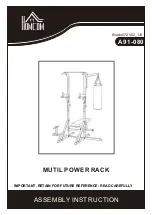
LBH-1700 (June, 2001) 1/2
LBH-1700SA
Model name
Max. sewing speed
Needle bar stroke
Max. lift of the work clamp
Number of stitches
Buttonhole length (mm)
Needle (at the time of delivery)
Hook
Material feeding method
Number of patterns that can be input
Machine head drive system
Power consumption
Lubrication
Lubricating oil
Weight
LBH-1700
3,600rpm
34.6mm
12mm
Automatically computed from the size of the buttonhole and stitch pitch
Displayed at the digital operation panel
Knife size: 6.4
〜
31.8
Stitch pitch: 0.2
〜
0.7
Bartacking length: 0.7
〜
5.0
Bartacking width (max.): 5.0
Knife groove width: 0
〜
1.5
DP
×
5 (#11J) #11J
〜
#14J
DP type, full-rotary hook
Intermittent feed by a stepping motor
Max. 89 patterns
Compact AC servomotor (direct-drive system)
400VA
Automatic
JUKI New Defrix oil No.1 (equivalent to ISO VG7)
Machine head (include motor) 63kg, Control box 13.5kg
●
Many different buttonhole shapes can be selected on the operation panel.
The machine is able to store as many as 89 different sewing patterns in
memory to permit the free selection.
●
The newly adopted basting stitch is effective on elastic materials such as
knits. The basting stitch helps prevent distortion when sewing knit or
stretchy materials.
●
Needle thread tension controlled by active-tension.
(electronic thread-tension-control system)
Needle thread tension for sewing parallel and bartacking sections of
buttonholes can be separately controlled through the operation panel and
stored in memory according to various sewing conditions (e.g., type of
thread, type of material and sewing speed).
The machine is able to change the needle thread tensions at the parallel
and bartacking sections of the buttonhole, to produce a beautiful
buttonhole shape.
This capability helps greatly in preventing thread breakage.
●
Changeover between purl stitching and whip stitching can be performed
easily on the operation panel.
●
For double stitching, only the parallel portions of a buttonhole will be
stitched under the double stitching mode while skipping the bartacking
sections. This allows the bartacks of a buttonhole to remain soft.
●
Knife replacement is no longer necessary when changing the buttonhole
size. To support the small-lot production system where the buttonholing
size is frequently changed or the cycle sewing for buttonholes that are
different in size, the number of times the knife is dropped to cut the
material can be automatically established according to the buttonholing size.
●
Three different cycle sewing programs can be registered, each of which can
store up to 15 different patterns in memory.
Data on needle thread tension, buttonholing length, stitching shape, etc.,
LBH-1700
Computer-controlled Lockstitch Buttonholing Machine
SPECIFICATIONS
9
















































